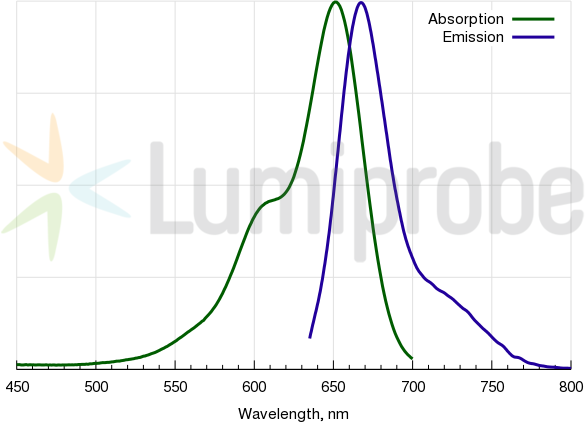Cyanine5 carboxylic acid
| Cat. # | Quantity | Price | Lead time | Buy this product |
|---|---|---|---|---|
| 13090 | 1 mg |
$110
|
in stock | |
| 23090 | 5 mg |
$210
|
in stock | |
| 43090 | 25 mg |
$410
|
in stock | |
| 53090 | 50 mg |
$695
|
in stock | |
| 63090 | 100 mg |
$1190
|
in stock |

Non-activated carboxylic acid, an analog of Cy5® free carboxylic acid. Contains Cyanine5 fluorophore.
This dye has limited water solubility, but can be dissolved in mixtures of water with organic phase (DMF, DMSO, alcohols) to obtain useful concentrations of the material in solution. Water-soluble version is available.
This molecule can be considered non-reactive dye for the use in control samples, and for instrument calibration. For coupling with amines and protein labeling, consider using Cyanine5 NHS ester, or water-soluble sulfo-Cyanine5 NHS ester.
Cyanine5 absorbance and emission spectra

Customers also purchased with this product
General properties
| Appearance: | dark golden solid |
| Molecular weight: | 519.12 |
| CAS number: | 1032678-07-1 (chloride), 195867-59-5 (inner salt), 766503-38-2 (without anion) |
| Molecular formula: | C32H39ClN2O2 |
| IUPAC name: | 3H-Indolium, 2-[5-[1-(5-carboxypentyl)-1,3-dihydro-3,3-dimethyl-2H-indol-2-ylidene]-1,3-pentadien-1-yl]-1,3,3-trimethyl-, chloride |
| Solubility: | soluble in organic solvents (DMF, DMSO, dichloromethane), very poorly soluble in water (0.25 mM, 130 mg/L) |
| Quality control: | NMR 1H, HPLC-MS (95%) |
| Storage conditions: | Storage: 24 months after receival at -20°C in the dark. Transportation: at room temperature for up to 3 weeks. Avoid prolonged exposure to light. Desiccate. |
| MSDS: | Download |
| Product specifications |
Spectral properties
| Excitation/absorption maximum, nm: | 646 |
| ε, L⋅mol−1⋅cm−1: | 250000 |
| Emission maximum, nm: | 662 |
| Fluorescence quantum yield: | 0.2 |
| CF260: | 0.03 |
| CF280: | 0.04 |
Product citations
- Tchatchiashvilli, T.; Duering, H.; Mueller-Boetticher, L.; Grune, C.; Fischer, D.; Pletz, M.W.; Makarewicz, O. PEG-PLGA nanoparticles deposited in Pseudomonas aeruginosa and Burkolderia cenocepacia. Journal of Pharmaceutical Analysis, 2024, 14(12), 100939. doi: 10.1016/j.jpha.2024.01.007
- Yao, P.; Wang, X.; Wang, Q.; Dai, Q.; Peng, Y.; Yuan, Q.; Mou, N.; Lv, S.; Weng, B.; Wang, Y.; Sun, F. Cyclic RGD-Functionalized PH/ROS Dual-Responsive Nanoparticle for Targeted Breast Cancer Therapy. Pharmaceutics, 2023, 15(7), 1827. doi: 10.3390/pharmaceutics15071827
- Lu, Y.; Zhou, J.; Wang, Q.; Cai, J.; Yu, B.; Dai, Q.; Bao, Y.; Chen, R.; Zhang, Z.; Zhang, D.; Hou, T. Glucocorticoid-Loaded PH/ROS Dual-Responsive Nanoparticles Alleviate Joint Destruction by Downregulating the NF-ΚB Signaling Pathway. Acta Biomaterialia, 2023, 164, 458–473. doi: 10.1016/j.actbio.2023.04.012
- Rezaei, S.; de Araújo Júnior, R. F.; da Silva, I. L. G.; Schomann, T.; Eich, C.; Cruz, L. J. Erythrocyte−cancer Hybrid Membrane-Coated Reduction-Sensitive Nanoparticles for Enhancing Chemotherapy Efficacy in Breast Cancer. Biomaterials Advances, 2023, 151, 213456. doi: 10.1016/j.bioadv.2023.213456

























 $
$ 
